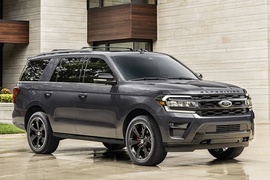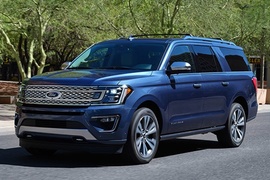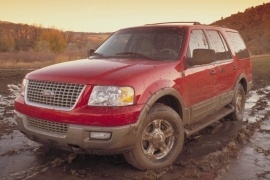
FORD Expedition
Generations Timeline, Specs and Pictures

Ford refreshed the fourth generation of the Expedition lineup in 2021 for the 2022 model, adding some changes here and there while removing some other features.
The carmaker built the Expedition with family needs in mind ever since the first generation, which appeared on the market in 1996. By 2018, when it launched the fourth sequel of the full-size SUV, the car was more or less an expensive luxobarge built to tow campers, boats, and other trailers for family activities.
For the 2022 model, the carmaker noted its customers’ preferences and added some changes. On the outside, the main changes were for the paint, where it deleted the Blue and Gold colors, replacing them with the Antimatter Blue and the Kodiak Brown ones. In addition, since the Expedition had to cope with various demands, from off-roading to trailer hauling and family trips, Ford provided the vehicle with a wide option of wheels ranged between 17” and 22” in size.
Ford also tried to answer better to its customers’ demands when it made the 2022 Expedition available in 13 equipment groups. Despite an increasing demand for comfort, the carmaker deleted the conversation mirror from the overhead console. In the safety department, the carmaker worked on the Ford Co-pilot360 Assist and offered it as standard on the Limited version. In addition, an 8” LCD Capacitive Touchscreen with swipe capability, Android Auto, and Apple CarPlay was included in the STX package.
The main differences on the drivetrain were for the Electronic Limited Slip Differential (eLSD), which was removed from the Heavy-Duty Trailer tow package and introduced as an option for the rest of the range.

Before the official release at the Chicago Auto Show, Ford unveiled the fourth generation of the Expedition at Ford Center in Texas.
It was a completely new vehicle.
Based on the same chassis as the Ford F150 and the luxurious Lincoln Navigator, the Expedition showed no mercy for its competitors. It came with new ideas and new technical solutions to outcome the most critical problem of a large SUV: weight.
By designing most of the body panels from aluminum and using high-strength steel for the ladder-chassis, the Expedition succeeded in losing weight. Smart design for the front area enhanced the aerodynamic. With these measures, the American car-maker tried to increase the fuel-efficiency, a place where large SUVs are struggling. And it was not about the cost; it was about pollution. All these solutions contributed to a weight loss of 300 lbs (150 kg.)
Since it was available in two wheelbase configuration, the Expedition could carry up to nine people on-board. The large instrument cluster was available as a mix between analog and digital displays or a completely digital unit. The integrated infotainment touch-screen was installed on the center stack and featured connectivity with Apple CarPlay and Android Auto. On the center console, a rotary knob controlled the gearbox.
Under the hood, the Expedition featured a 3.5-liter turbocharged V6 unit in two power-output configurations. Both were mated as standard to a 10-speed automatic gearbox, and both were available with a front- or all-wheel-drive system.

The typical American full-size SUV, the Expedition Max released in 2017 came with improved technology, comfort and new safety features designed for large families.
The first generation of the Expedition came to life in 1997 and was one of the most desired SUV.
20 years later, the 2017 Expedition brought a completely new car.
The cabin had soft touch quality materials, lots of storage spaces for both the front and the 2nd row and could accommodate up to 7 people.
The Expedition was equipped with powered windows and mirrors, keyless go, a touchscreen display for media, Bluetooth and navigation, as well as the standard MP3 and radio, Apple CarPlay and Android auto.
Comfort wise, the powered seats were both cooled and heated and equipped with lumbar support, controls were intuitively placed on the steering wheel and headroom and legroom was decent even for the 2nd and the 3rd row.
The access to the 3rd row was made easy with electrical seat in the 2nd row, which would fold at the push of a button, same for the seats in the 3rd row which could be folded by pressing the button located in the trunk. Grab handles were also placed well to ease access.

Compared to the previous model, the redesigned 2014 Pathfinder was less of an off-roader and more of a family oriented SUV.
For 2014, Nissan also presented their first SUV hybrid.
The budget SUV was offered with 4 trim levels, S, SV, SL and Platinum. All of the trim levels came with either 2WD or 4WD, however, it was not a permanent 4x4, users could switch between the two.
The engine mounted on the Pathfinder was the same regardless of the trim level, a 3.5-liter V6 powerplant developing 260hp. The engine was mated to CVT transmission.
As we would expect, the Pathfinder had a big towing capacity, as well as lots of load space, mostly with the 3rd row of seats folded. Yes, a 3rd row was included in the package, which meant that the Pathfinder could accommodate up to 7 people.
The tail gate could be opened in 3 different ways: using the button located near the steering wheel, using the button on the car’s key or by touching the pad underneath the chrome accent on the lid.
Both the 3rd and the 2nd row of seats were foldable, fairly flat. Under the floor board was some extra storage room, as the spare tire was placed underneath the SUV.
Seating in the 2nd row seats would have offered decent legroom, as well as headroom (taller people could use the help of the optional panoramic sunroof) and the seats were also reclinable.

The third generation of the Ford Expedition was also known as the “poor’s man Lincoln” since they were identical from the technical point of view.
Ford F-Series was the most sold vehicle globally, and the blue-oval brand tried and succeeded in keeping its pickup range ahead of the market. Based on that success, the American carmaker produced a large SUV good for taking a family to a week-long camping trip with a boat attached to its trailer hitch.
The design team took their inspiration from the F-150 cues. A big, bold, three “hollow-bar” grille and large headlights tried to look intimidating with their size. Ford offered the Expedition in two lengths. The EL (or Expedition Max on other markets) version added 14.8” (375 mm) to the regular version. Since the Expedition was more than just a regular big SUV, Ford offered various exterior upgrades, including side-steps and 20” chrome-clad, five-spoke wheels.
The interior was as versatile as in a large MPV. It was available with up to eight seats in a 2-3-3 configuration. Two captain seats could have been ordered for the second row, and a passage-through for the rear bench. Needles to say, but the cargo area with all the seats folded was cavernous: with all seats up, it offered 18.6 cu-ft (526 liters). With the third row folded, it increased to 55 cu-ft (1557 liters), and with the second and third-row lowered, it reached 108.3 cu-ft (3066 liters).
The Expedition featured a 5.4-liter V8 engine paired to a 6-speed automatic gearbox as standard. It was available with a front- or all-wheel-drive system. Thanks to that configuration, it could pull up to 9000 lbs (4082 kg).

The second generation of the Expedition offered the same seven-seat capability as its predecessor and suffered from no less than six recalls from the NHTSA.
Ford had to deal with four recalls imposed by the NHTSA (National Highway Traffic and Safety Administration) for the first Expedition generation. The second one received six of them. But it was still a car worth the money since it was able to carry seven and tow up to 4037 kg (8,900 lbs).
The new-look offered a mesh-grille with a rectangular pattern and the blue-oval badge in the middle. Its styling was inspired by the F150 pickup-truck look, with similar headlights and front panels. To help passengers get inside, Ford offered a set of side-steps as an option. The Expedition featured a big liftgate in the back, and the blacked-out D-pillars made it look like it had wrap-around windows for the trunk area.
Even though it was the more luxurious Lincoln Navigator’s sibling, the Expedition featured a less exclusive interior, with cloth seats for the base trim level. Ford offered higher trim levels with wood-grain and leather seats fitted as an option. One of the Expedition’s key features was the interior versatility, which allowed the vehicle to be transformed into a minivan or a sleeping place.
But the Expedition’s main problem was the fuel-efficiency, which was mostly in the one-digit area. The thirsty V8 units offered were paired to a 4-speed automatic transmission.

Ford introduced the first generation of the Expedition in 1996 to answer a public that demanded more comfortable SUVs.
Since the Bronco was already an aged vehicle, the blue-oval brand needed something else. Instead of introducing a new generation for the iconic model, it created a new lineup: the Expedition. Ford built the vehicle on a new platform shared with the F-150. It was a costly program, but the results worth the effort. In May 1996, Ford introduced the Expedition and became a gamechanger on the market. It finally had something to put against Chevrolet Tahoe.
While it wasn’t a premium vehicle, the Expedition showed a dominant front fascia with a chromed surrounding for the mesh-grill and accompanied by a chromed bumper. Its rounded, horizontal headlights looked more up to date than the squared-looking ones offered by its competitors. As an option, Ford offered lightened running boards and side steps which decreased the ground clearance, but that didn’t matter for those who used the vehicle only on pavement.
Inside, Ford offered the Expedition with an option for a third seat row and captain seat in the second row. With an option for leather upholstery and a premium sound system, it was already a suitable choice for the premium-segment customers.
Ford offered the Expedition with a standard 4.6-liter V-8 engine and a 4-speed automatic transmission. The locking center differential and low-range gear were also fitted as standard. A 5.4-liter V-8 was available at extra cost.























































